The Power of Suggestion: 3 Key Elements of Streamer Fly Design

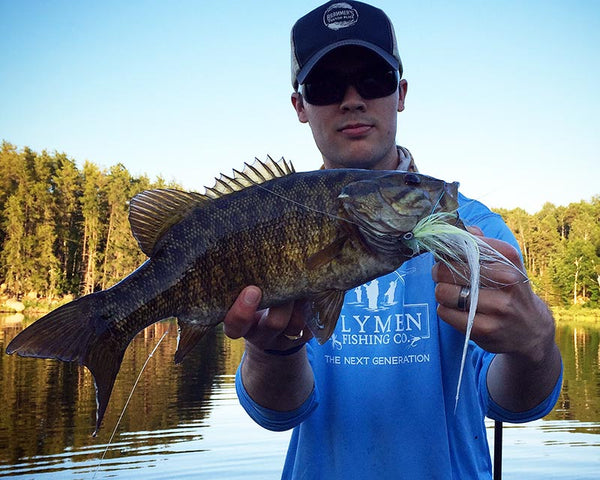
Everything We Create in the Search to Fool Fish Is an Imitation of Life, a Suggestion of Realism
A size #16 Adams, a 4/0 Flashabou streamer, and even a #14 Husky Jerk are all attempts to convey the same thing to the fish we target with them — that they are food.
How closely they imitate life, and how well they suggest their intended identity are what make flies successful, or not.
What I want to discuss is a simple idea, and this idea applies to every fly, lure, and flure that has, or ever will exist. The idea is in regards to a predator's search image, and its impacts on design and design simplicity.
What is a search image?
It's a subconscious mental folder. Within this folder is a range of images, used as references, to improve the reaction time in prey identification.
In the world of wildlife ecology, it is a variable of kill rate, measuring the efficiency of a predator’s ability to capture prey. In the world of fishing, they are often referred to as “triggers."
That may sound like a bunch of mumbo jumbo, and that's because it is…
So, let’s bring it back to reality for a bit.
Have you ever stopped alongside a river and looked for fish? Or perhaps peered over the side of a bridge crossing a downtown stream?
My guess is the first fish took the longest for you to find it. Your mind was not exactly sure of what it needed to look for.
As soon as you see the first fish, your mind creates a list of reference images.
These may include its length and width, the movement of its tail, the position of its shadow, and its contrast against the stream bed.
You begin to distinguish the difference between the movement of weeds with their fixed anchors from that of a living creature, having freedom to dodge left or right, leading nose first.
You see the shine from its side as it turns and chases down a caddis, and the changing proportions of its shadow against the tumbling cobble.
Once you find the first fish, the second and third quickly come into view. Within seconds you find yourself able to locate nearly all the fish within the pool below.
Unknowingly, you created a search image, and, just like you, fish do the same thing.
Search imagery has a range of influences on fly design, and although it's capable of overwhelming us with complexity, search imagery may also lead us to the simplest form of any fly design.
There are only 3 things I truly care about when designing a fly.
These 3 things are what I believe have the greatest impact on a fly's effectiveness, and each plays off of the idea of a predator's search image.
1. Silhouette
I vividly remember sitting down on my first day of ornithology at Michigan Tech.
I had a 20-minute walk to school in 10-degree Fahrenheit weather, with sweat freezing to my forehead, and lacking the appropriate caffeine buzz for an 8 a.m. class.
I eagerly sat in the front row (believe it or not), and stared at my iPod with music blaring. The first pile of paper started to get passed around. It was thick, horribly thick, and the Professor said, "read it."
I stared at the cover for about 10 seconds, blinking slowly, and gave a heavy sigh as I turned the page.
What I found was a picture, and the picture was titled something like, “identifying bird species by their silhouette."
The contrast of the black and white photo burned easily enough into my head.
Trout Fly Fishing: 3 Bad Habits to Break
You could see the cocked tail of a wren perched in chest-high grass and the chicken-like profile of a grouse seated below. Mourning doves were perched on the telephone wires and the steep crest of a cardinal could be seen hanging from the feeder. An owl sat perched in a tree branch with its ear tufts piercing into the sky accompanied by a nuthatch facing downwards on the trunk.
I didn’t need the songs that filled the morning air, or the light that came with sunrise to identify what was before me.
All I needed was a little contrast.
The silhouette of a fly can be everything. Consider how drastic a difference there is between a baitfish and a crawdad. How about a Double Deceiver and a Nancy P.?
It's a pretty big deal.
When a predator begins to pursue and target specific prey sources, the silhouette of that source is a primary means of identification. The effects and influence of silhouette are often taken to extremes in saltwater fishing scenarios, where the subtle bumped snout of an anchovy imitation can make or break a day on the water.
Here in the Midwestern United States, I simplify my silhouettes into 3 primary categories: baitfish, bottom dwellers, and crayfish.
Baitfish
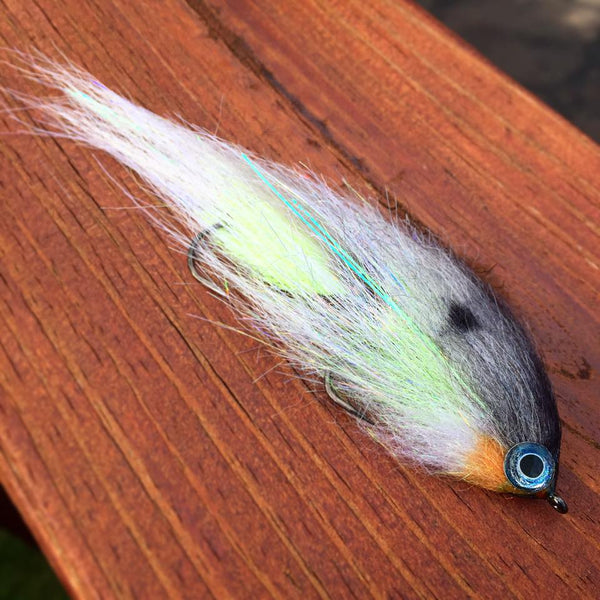
Super Jerk streamer.
Shad, shiners, cisco, herring, whitefish and juveniles (4”-10”): Narrow, yet deep, and most often using the hook gap as the sole keeling force to maximize action.
This allows the deep body to act as a sail to catch lateral currents, while the subtle keel allows the fly to wobble and catch updrafts on the pause, imitating a dying/wounded fish.
The flies are most often tied with an overall proportion of 65% length, 35% bulk, and are often compressed laterally with oversized eyes.
When weighted with coneheads or lead eyes, I often round out the pattern, yet keep the same proportions.
Bottom Dwellers

Martian streamer.
Sculpin, gobies, chubs, and suckers (4”-6”): Built in a 360-degree fashion, typically utilizing materials that can be palmered, and often using a darker stacked winged material over the body section.
Though these flies can again be tied in a 65/35 length to bulk ratio, the emphasis is placed on the head and shoulder region with the proportions being applied in a conical fashion.
The heads are wide and bulky, often flattened on the underside, and are often paired with oversized pectoral fins.
Crawfish

Monster Craw tied with the Fish-Skull Shrimp & Cray tail.
Crawfish (2”-4”): Two large claws the length of the body with trailing elongated antennae. Bulkiest towards the hook bend and reducing gradually toward the hook eye with an enlarged tail. Webby/picky underbelly proportional to the tapered body to accurately imitate legs.
What I hope you pull from these descriptions is that it's not only important to match the length of a forage species, but all dimensions, volume included.
When you imitate a baitfish, the lateral compression can be viewed from the rear, as well as from underneath. We fish in a 3-dimensional space, and fish are not always seeing our flies from the side perspective.
By matching the volume of the fly to that of its intended forage, it will give a more appropriate silhouette from all angles, triggering more strikes.
2. Color
Predators respond to various colors under various conditions, and how an angler reacts to these conditions will likely determine his/her success or failure on the water.
Almost every streamer junkie acknowledges the old saying, “bright day/bright fly, dark day/dark fly."
And certainly almost all of us have likewise experienced the exceptions that come with applying rules to the infinite variables associated with fishing.
Although I believe this rule points most anglers in the right direction, I do not follow it myself, but instead have modified it to better suit my water here in Duluth, Minnesota.
Having lived in Duluth for the past year, I've been faced with the challenge of figuring out and learning new water.
Fly Selection: How to Choose the Right Streamer Color for Any Fishing Situation
Slightly acidic and stained by northern bogs, the coffee-colored waters of the Cloquet and St. Louis Rivers are home to some of the feistiest bronzebacks in the area.
I would search Google Earth for various access sites, and drive up and down the river systems attempting to find wadable water. After finally managing to locate a fishy area, I was faced with navigating the dark-stained, boulder-strewn river systems. With overgrown silver maples, ash, and alder, swarms of mosquitos buzzing in my ears, and banks crowded with chest-high grass, fly selection was the last thing on my mind.
What I quickly learned was these smallies didn’t seem to notice their hampered vision, nor the clouds in the sky.
These fish, night or day, stormy or clear, loved to eat white flies!

Caught on the Hollow Point streamer.
I tried fishing black flies, copper flies, yellow and chartreuse. They all caught a few fish here and there, but nothing has been able to out compete the luster of a White Hollow Point.
When predators are selectively targeting shad, and for the sake of my argument hammering white flies, why would a change in conditions bring about a change in fly selection?
Fly Selection and Speed of Current
The impact of light or water clarity on the predator’s ability to find shad equally impacts my fly. If a silvery shad now appears a bit darker with the lack of clarity, wouldn’t my white fly appear equally so?
So…if they are still eating shad, shouldn’t they still be on white? This is something I have wrestled with over this past year and has ultimately led me to my adaptation of the age old rule.
The adaptation is simple, “bright day/flashy fly, dark day/dull fly”.
This concept was clarified for me during one of Kelly Galloup's rants in regards to nymphing. He was addressing fly selection and placement while explaining his preferred technique of high-stick nymphing, or drop shotting.
The concept is rather intuitive, yet overlooked by most. The bottom fly in a two-fly rig, should be duller, while the fly riding higher in the water column, should be brighter (flashback, or general attractor, etc.).
There is less light near the bottom of the river, so why would the bottom nymph be giving off the more light? It wouldn’t.
By selecting a duller fly as your bottom bug, and a flashier fly as your top bug, you more accurately imitate what is naturally occurring, and become less likely to get a refusal from Mr. Brown Trout.
Fly Fishing for Predators: 3 Ways To Entice an Aggressive Eat
When you apply this concept to streamer fishing, it gives an interesting perspective. When conditions change, instead of changing out your white fly for a black one, try switching to a duller version of a similar color combo. Moving from a highly reflective Super Jerk to a more subtle CH Barely Legal will often keep the fish hitting hard, even when conditions are changing.
When you make this subtle change, you align your fly selection with the adapted search image of the predator.
Instead of keying in on flash, wobble, and the scattered light brought forth by a bright day, it is likely that the search image has been updated to rely more prominently on silhouette and duller colors.
A flashy fly would simply be out of place, and perhaps spook a fish that was previously aggressive for those exact reasons.
The application of this rule depends greatly on the forage of the system. My example used shad and white flies, but I’m suggesting that the application goes beyond white flies to all the colors that appropriately match primary forage such as sculpins and gobies (black, olive, brown), suckers (tan/white, red/white, black/yellow/white), and juvenile trout (olive/white/pink, brown/yellow/gold), etc.
When trout are on sculpins for example, and olive-based flies are hammering fish, try a flash-based olive for bright conditions, and a dull version for cloudy/dirty water conditions.
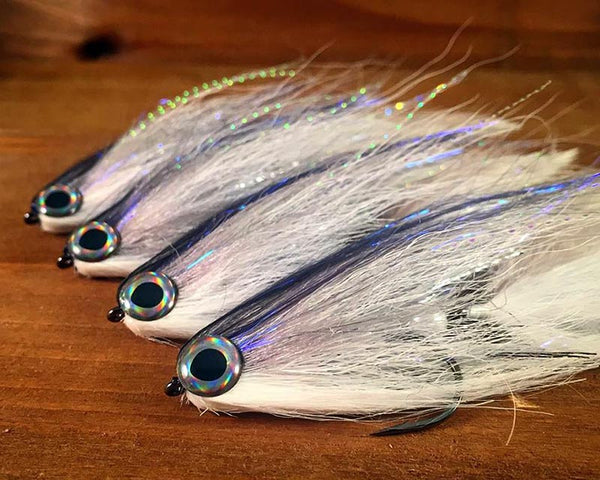
Hollow Point streamer tied with Fish-Skull Living Eyes and Ice Dub Shimmer Fringe.
Applying this to your tying is simple.
For bright day bugs, try adding a wing of Ice Dub Shimmer Fringe to the top of, or Ice Dub, to the bottom of your favorite color combo, but omitting them for darker water or cloudier days.
The concept of color can be taken in almost any direction.
While the idea of matching a predator’s search image can make for increasingly complex flies, it also has equal potential to simplify things.
3 Simple Tactics for Fly Fishing Pocket Water
Some days (emphasis on “some”), olive is the primary search image, regardless of flash or silhouette — sculpin, baitfish, or crawdad.
In a similar fashion, when we generated our own hypothetical search image earlier, contrast against the bottom substrate may have been the easiest means of identification and was therefore focused on more heavily.
Sometimes the fish are simply keyed in on olive, just as they could be keyed in on a specific silhouette. It may have to do with the visibility and clarity, or perhaps there is a high density of forage within that color range that fish are preying on.
Regardless, fish use color, just as they use silhouette as a means of identifying what is food and what is not.
The emphasis of their focus and how heavily they weigh their search image likely varies day to day, and is most certainly influenced by external factors.
3. Action
When I introduced the idea of a search image, I mentioned something that most of us are familiar with in the predator-fishing community: trigger points.
Instead of going over styles of bugs that fool fish on a regular basis, let us instead highlight some very specific triggering mechanisms, how they are applied to fly tying and fly selection, and their impact in regards to a search image.
Water Push

Sculp Daddy streamer.
The displacement of water, often combined with articulation joints, or elongated tailing materials, is what brings a fly to life.
The “S” movement while the fly is under tension — something so many of us desire to see in our bugs — is directly related to the movement of water pushing over the shoulders of the fly.
It is the displacement and realignment of the water particles that accentuates the tailing materials and articulations.
This action is often twofold.
The displacement of water sends off sound waves. These vibrations can be sensed using a fish’s lateral line, helping to add a surreal element of realism to a fly.
The Dark Side… Night Fishing for Big Brown Trout
Additionally, a head that pushes water is likely also one to add substantial water drag. This friction is what slows the head of the fly down when pausing during the retrieve, resulting in a massive kick and sway of the tail.
It's often during these exaggerated moments that the eat happens.
Just like when you looked over the side of that bridge and slowly started to develop your search image between the fish and their surroundings, it's these swimming motions, the “S” shape animation of the fly that gives the fly life, that allows you to sell it as the real deal.
The principles that need to be in place for this action are straightforward.
Always consider placing friction forward — bulky head, slippery tail, and minimal weight.
By aligning these principles with the proportions of the previously mentioned silhouettes, the results are some pretty nasty bugs that will hunt it up.
I most frequently apply these principles to bottom-dweller style flies, which sport the larger bulkier heads; however, this is an extremely effective technique on every style of fly, especially larger single-hook patterns (6-8”) similar to extended-body hollow flies and bulkheads, for targeting freshwater and saltwater species alike.
Showing the Profile

Imposter streamer.
A fly that shows its profile is a fly that will get smashed!
It's on the turn (similar to the exaggerated “S”) when a fly is most vulnerable.
During these split second moments, a predator has the greatest opportunity to stun, kill, or simply eat the fly. The primary reason for this is because it is within this opportune moment a predator can safely pinpoint its attack at the head.
Forage has evolved with two primary ways to cope with predation:
- Defend yourself
- Outmaneuver and escape
Most forage species are equipped with dorsal and anal spines, or enlarged pectoral spines, or razor-sharp points on their gill plates, all of which are designed to deter a predator from eating a fish tail first and are often associated with bottom dwellers as well as upper trophic-level mesopredators such as perch, walleye, and bass.
This motivates a predator to respond by attacking prey head first.
Aside from defense, forage species are also built for maneuverability.
Consider the described silhouette for most of my baitfish recipes. Narrow, deep-bodied, and laterally compressed. These features, which enable a fly to respond similarly to a jerk bait (digging left/right, acting like a sail), function identically for a true baitfish.
It's their deep-bodied sail that enables them to turn on a dime and escape predation.
A fly that is able to show its profile by mimicking this jerk bait-like action, is one that most appropriately mimics a fleeing wounded baitfish, often triggering the predator that may not have responded otherwise.
Eyes
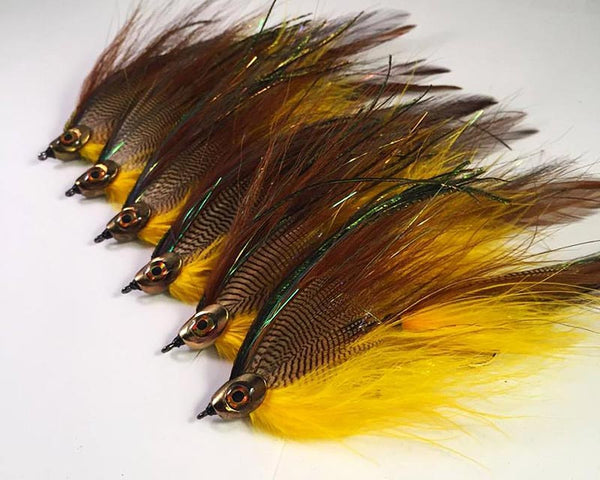
Trutta's Demise streamers tied with Fish-Skull Baitfish Heads.
Eyes become a primary factor in a predator's search image because they give the necessary information to safely attack and consume a prey item and are extremely visible on flies that show their profile.
Aside from the added realism, they hold an immense value to a fly tyer attempting to imitate these larger jerk bait-style flies. The eyes are oftentimes the sole compression force on the head of a streamer, something that animates the fly.
Aside from eyes, slotted heads such as Baitfish Heads and Fish-Masks are perfect for imitating this compression and are often enough to give an extremely erratic action to this style of fly.
I prefer Baitfish Heads on my smaller 4”-6” designs, and Fish-Masks for 7”+ streamers, coupled with a more viscous collar to allow the elongated tailing material to articulate.
Quick Review
The simple things can make a big difference when you try to sell your bug as the real deal.
It can be as simple as the tapering of a crawdad body, or adding a picky underbelly to suggest legs. Things such as matching your silhouette to your intended forage, and integrating flash for bright day bugs. It could be a simple stack of dubbing that pushes water and brings the “S” into your tail, or a calculated eye placement that compresses your baitfish.
All of these things are simple suggestions. They suggest life; they suggest a shiner, sculpin, or crawfish. They ultimately suggest that they are food, and when paired with an articulated or jerk-style action, that suggestion is often that they are injured and will be an easy meal.
The combination of these principles results in a powerful suggestion of realism that is sure to fool any predator; all you have to do is give them what they are looking for.
Pro Tip
When animating large flies, say 7” to 10” or so, keep your rod tip low at the surface of the water and animate the fly with a straight hard strip.
It's extremely important that the primary animation is on the lateral plane, especially with big rods and heavy lines.
When your rod tip is too high off the water, the animation force is split into lateral and vertical components. The vertical goes into the lifting and falling of the fly line and as the line falls it will add tension to the fly. This dampens the fly’s ability to articulate and/or jerk left and right, and the result is a straight retrieve with minimal action.
By keeping the rod tip low, the fly is able to use the moment of slack tension between strips to truly come alive.
Want More Articles Like This?
Join the Flymen Mailing List at the Bottom of the Page!
About Gunnar Brammer:
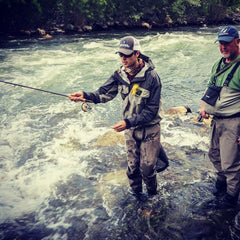
After being afflicted with the fly tying and fishing addiction at the impressionable age of 16, Gunnar spent the next few years honing his skills on the water and at the fly tying desk, including a memorable summer spent working for Kelly Galloup at Galloup’s Slide Inn. In 2015 he launched Brammer’s Custom Flies, a business specializing in musky, pike, and large trout streamers. He’s proud to say the streamers are all his own, but credits his inspiration to many great tyers. He’s actively building out his YouTube channel and Instagram in an effort to provide a wealth of information for others who share his passion for fly tying and fishing. Gunnar recently moved to Duluth, Minnesota with his wife, where he’s looking forward to the challenges of new waters and hopes they will inspire some tasty treats for others to enjoy.


Very informative , living in Montana fishing daily for trout I started to devote hot summers pursuing northern pike with articulated streamers and live it
Please ad me to your mailing list if is okay !
Regards ,
Les
Great article! Mailing list please.
Awesome info!! When does the book come out?
Fantastic information Gunnar. Thank you for sharing your knowledge and techniques.
Looking forward to learning from you, and to benefitting from your products!
Leave a comment